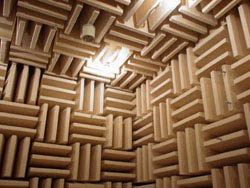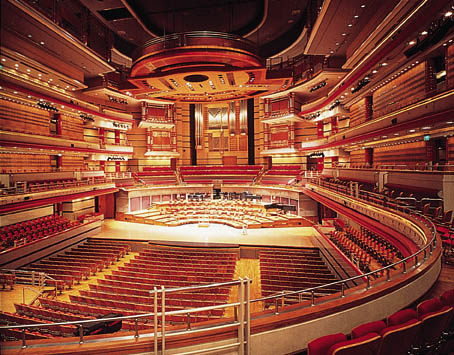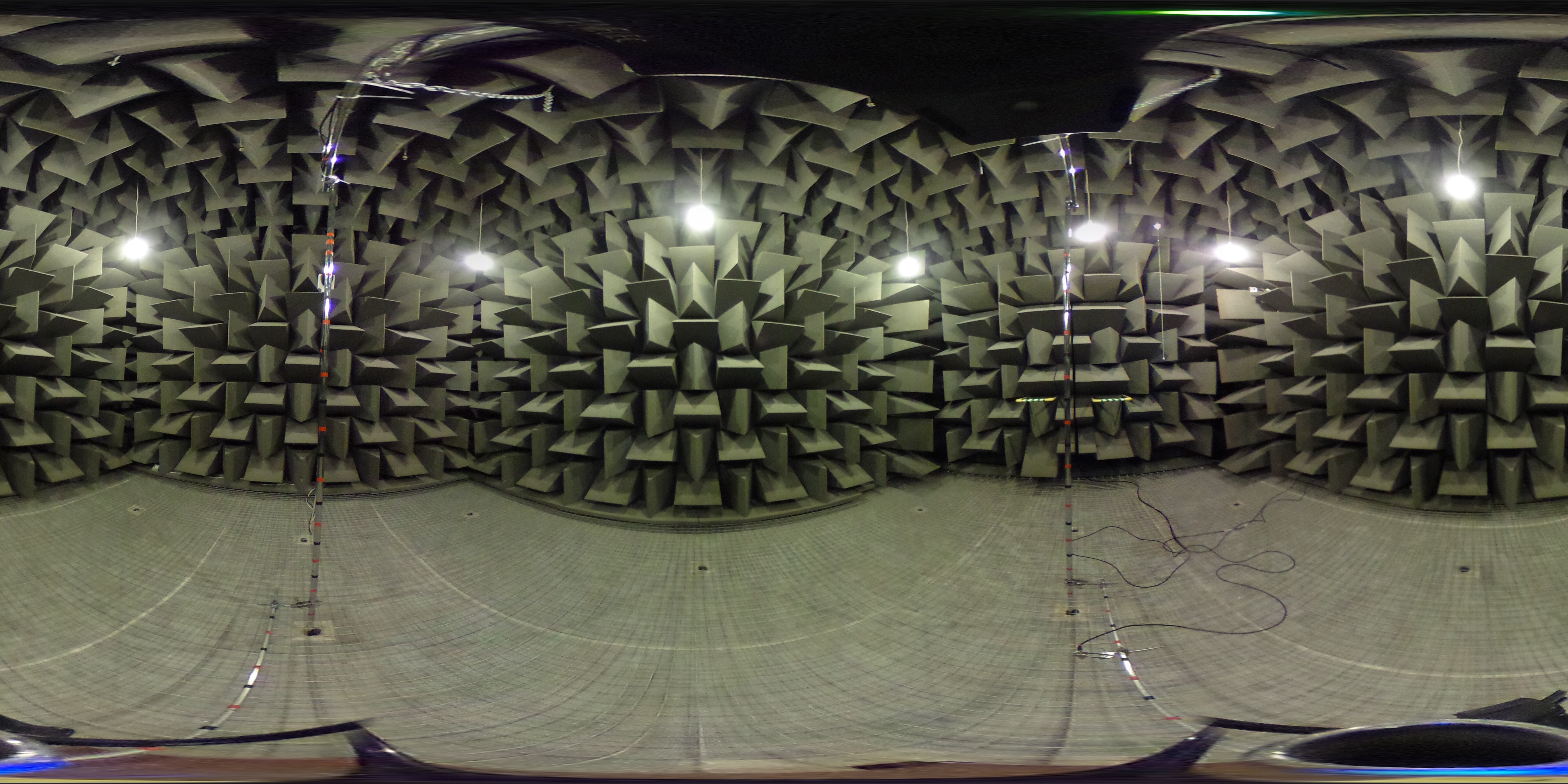|
Absorption (acoustics)
Acoustic absorption refers to the process by which a material, structure, or object takes in sound energy when sound waves are encountered, as opposed to reflecting the energy. Part of the absorbed energy is transformed into heat and part is transmitted through the absorbing body. The energy transformed into heat is said to have been 'lost'.Acoustic Absorbers and Diffusers: Theory, Design and Applicatio.CRC Press .2009.Peter D'Antoni When sound from a loudspeaker collides with the walls of a room part of the sound's energy is reflected, part is transmitted, and part is absorbed into the walls. Just as the acoustic energy was transmitted through the air as pressure differentials (or deformations), the acoustic energy travels through the material which makes up the wall in the same manner. Deformation causes mechanical losses via conversion of part of the sound energy into heat, resulting in acoustic attenuation, mostly due to the wall's viscosity. Similar attenuation mechanisms ap ... [...More Info...] [...Related Items...] OR: [Wikipedia] [Google] [Baidu] |
Acoustics
Acoustics is a branch of physics that deals with the study of mechanical waves in gases, liquids, and solids including topics such as vibration, sound, ultrasound and infrasound. A scientist who works in the field of acoustics is an acoustician while someone working in the field of acoustics technology may be called an acoustical engineer. The application of acoustics is present in almost all aspects of modern society with the most obvious being the audio and noise control industries. Hearing is one of the most crucial means of survival in the animal world and speech is one of the most distinctive characteristics of human development and culture. Accordingly, the science of acoustics spreads across many facets of human society—music, medicine, architecture, industrial production, warfare and more. Likewise, animal species such as songbirds and frogs use sound and hearing as a key element of mating rituals or for marking territories. Art, craft, science and technology h ... [...More Info...] [...Related Items...] OR: [Wikipedia] [Google] [Baidu] |
Reverberation Room
A reverberation chamber or room is a room designed to create a diffuse or random incidence sound field (i.e. one with a uniform distribution of acoustic energy and random direction of sound incidence over a short time period). Reverberation chambers tend to be large rooms (the resulting sound field becomes more diffused with increased path length) and have very hard exposed surfaces. The change of impedance (compared to the air) these surfaces present to incident sound is so large that virtually all of the acoustic energy that hits a surface is reflected back into the room. Arranging the room surfaces (including the ceiling) to be non-parallel helps inhibit the formation of standing waves - additional acoustic diffusers are often used to create more reflecting surfaces and further encourage even distribution of any particular sound field. Reverberation chambers are used in acoustics as well as in electrodynamics, such as for measurement microphone calibration, measurement of th ... [...More Info...] [...Related Items...] OR: [Wikipedia] [Google] [Baidu] |
Dissipation
In thermodynamics, dissipation is the result of an irreversible process that takes place in homogeneous thermodynamic systems. In a dissipative process, energy (internal, bulk flow kinetic, or system potential) transforms from an initial form to a final form, where the capacity of the final form to do thermodynamic work is less than that of the initial form. For example, heat transfer is dissipative because it is a transfer of internal energy from a hotter body to a colder one. Following the second law of thermodynamics, the entropy varies with temperature (reduces the capacity of the combination of the two bodies to do work), but never decreases in an isolated system. These processes produce entropy at a certain rate. The entropy production rate times ambient temperature gives the dissipated power. Important examples of irreversible processes are: heat flow through a thermal resistance, fluid flow through a flow resistance, diffusion (mixing), chemical reactions, and elec ... [...More Info...] [...Related Items...] OR: [Wikipedia] [Google] [Baidu] |
Sound Pressure Level
Sound pressure or acoustic pressure is the local pressure deviation from the ambient (average or equilibrium) atmospheric pressure, caused by a sound wave. In air, sound pressure can be measured using a microphone, and in water with a hydrophone. The SI unit of sound pressure is the pascal (Pa). Mathematical definition A sound wave in a transmission medium causes a deviation (sound pressure, a ''dynamic'' pressure) in the local ambient pressure, a ''static'' pressure. Sound pressure, denoted ''p'', is defined by p_\text = p_\text + p, where * ''p''total is the total pressure, * ''p''stat is the static pressure. Sound measurements Sound intensity In a sound wave, the complementary variable to sound pressure is the particle velocity. Together, they determine the sound intensity of the wave. ''Sound intensity'', denoted I and measured in W· m−2 in SI units, is defined by \mathbf I = p \mathbf v, where * ''p'' is the sound pressure, * v is the particle velocity. Acous ... [...More Info...] [...Related Items...] OR: [Wikipedia] [Google] [Baidu] |
Echo (phenomenon)
In audio signal processing and acoustics, an echo is a reflection of sound that arrives at the listener with a delay after the direct sound. The delay is directly proportional to the distance of the reflecting surface from the source and the listener. Typical examples are the echo produced by the bottom of a well, by a building, or by the walls of an enclosed room and an empty room. A true echo is a single reflection of the sound source. The word ''echo'' derives from the Greek ἠχώ (''ēchō''), itself from ἦχος (''ēchos''), "sound". Echo in the Greek folk story is a mountain nymph whose ability to speak was cursed, leaving her able only to repeat the last words spoken to her. Some animals use echo for location sensing and navigation, such as cetaceans (dolphins and whales) and bats in a process known as echolocation. Echoes are also the basis of Sonar technology. Acoustic phenomenon Acoustic waves are reflected by walls or other hard surfaces, such as mountains and ... [...More Info...] [...Related Items...] OR: [Wikipedia] [Google] [Baidu] |
Noise Barrier
A noise barrier (also called a soundwall, noise wall, sound berm, sound barrier, or acoustical barrier) is an exterior structure designed to protect inhabitants of sensitive land use areas from noise pollution. Noise barriers are the most effective method of mitigating roadway, railway, and industrial noise sources – other than cessation of the source activity or use of source controls. In the case of surface transportation noise, other methods of reducing the source noise intensity include encouraging the use of hybrid and electric vehicles, improving automobile aerodynamics and tire design, and choosing low-noise paving material. Extensive use of noise barriers began in the United States after noise regulations were introduced in the early 1970s. History Noise barriers have been built in the United States since the mid-twentieth century, when vehicular traffic burgeoned. I-680 in Milpitas, California was the first noise barrier. In the late 1960s, analytic acousti ... [...More Info...] [...Related Items...] OR: [Wikipedia] [Google] [Baidu] |
Sonar
Sonar (sound navigation and ranging or sonic navigation and ranging) is a technique that uses sound propagation (usually underwater, as in submarine navigation) to navigate, measure distances ( ranging), communicate with or detect objects on or under the surface of the water, such as other vessels. "Sonar" can refer to one of two types of technology: ''passive'' sonar means listening for the sound made by vessels; ''active'' sonar means emitting pulses of sounds and listening for echoes. Sonar may be used as a means of acoustic location and of measurement of the echo characteristics of "targets" in the water. Acoustic location in air was used before the introduction of radar. Sonar may also be used for robot navigation, and SODAR (an upward-looking in-air sonar) is used for atmospheric investigations. The term ''sonar'' is also used for the equipment used to generate and receive the sound. The acoustic frequencies used in sonar systems vary from very low ( infrasonic) to ex ... [...More Info...] [...Related Items...] OR: [Wikipedia] [Google] [Baidu] |
Architectural Acoustics
Architectural acoustics (also known as building acoustics) is the science and engineering of achieving a good sound within a building and is a branch of acoustical engineering. The first application of modern scientific methods to architectural acoustics was carried out by the American physicist Wallace Sabine in the Fogg Museum lecture room. He applied his newfound knowledge to the design of Symphony Hall, Boston. Architectural acoustics can be about achieving good speech intelligibility in a theatre, restaurant or railway station, enhancing the quality of music in a concert hall or recording studio, or suppressing noise to make offices and homes more productive and pleasant places to work and live in. Architectural acoustic design is usually done by acoustic consultants. Building skin envelope This science analyzes noise transmission from building exterior envelope to interior and vice versa. The main noise paths are roofs, eaves, walls, windows, door and penetrations. ... [...More Info...] [...Related Items...] OR: [Wikipedia] [Google] [Baidu] |
Room Acoustics
Room acoustics is a subfield of acoustics dealing with the behaviour of sound in enclosed or partially-enclosed spaces. The architectural details of a room influences the behaviour of sound waves within it, with the effects varying by frequency. Acoustic reflection, diffraction, and diffusion can combine to create audible phenomena such as room modes and standing waves at specific frequencies and locations, echos, and unique reverberation patterns. Frequency zones The way that sound behaves in a room can be broken up into roughly four different frequency zones: *The first zone is below the frequency that has a wavelength of twice the longest length of the room. In this zone, sound behaves very much like changes in static air pressure. *Above that zone, until wavelengths are comparable to the dimensions of the room, room resonances dominate. This transition frequency is popularly known as the Schroeder frequency, or the cross-over frequency and it differentiates the lo ... [...More Info...] [...Related Items...] OR: [Wikipedia] [Google] [Baidu] |
Acoustic Transmission Lines
An acoustic transmission line is the use of a long duct, which acts as an acoustic waveguide and is used to produce or transmit sound in an undistorted manner. Technically it is the acoustic analog of the electrical transmission line, typically conceived as a rigid-walled duct or tube, that is long and thin relative to the wavelength of sound present in it. Examples of transmission line (TL) related technologies include the (mostly obsolete) speaking tube, which transmitted sound to a different location with minimal loss and distortion, wind instruments such as the pipe organ, woodwind and brass which can be modeled in part as transmission lines (although their design also involves generating sound, controlling its timbre, and coupling it efficiently to the open air), and transmission line based loudspeakers which use the same principle to produce accurate extended low bass frequencies and avoid distortion. The comparison between an acoustic duct and an electrical transmissio ... [...More Info...] [...Related Items...] OR: [Wikipedia] [Google] [Baidu] |
Anechoic Chamber
An anechoic chamber (''an-echoic'' meaning "non-reflective") is a room designed to stop reflections of either sound or electromagnetic waves. They are also often isolated from energy entering from their surroundings. This combination means that a person or detector exclusively hears direct sounds (no reflected sounds), in effect simulating being outside in a free field. Anechoic chambers, a term coined by American acoustics expert Leo Beranek, were initially exclusively used to refer to acoustic anechoic chambers. Recently, the term has been extended to other RF and Sonar anechoic chambers, which eliminate reflection and external noise caused by electromagnetic waves. Anechoic chambers range from small compartments the size of household microwave ovens to ones as large as aircraft hangars. The size of the chamber depends on the size of the objects and frequency ranges being tested. Acoustic anechoic chambers The requirement for what was subsequently called an anechoic c ... [...More Info...] [...Related Items...] OR: [Wikipedia] [Google] [Baidu] |
Loudspeaker
A loudspeaker (commonly referred to as a speaker or speaker driver) is an electroacoustic transducer that converts an electrical audio signal into a corresponding sound. A ''speaker system'', also often simply referred to as a "speaker" or "loudspeaker", comprises one or more such speaker ''drivers'', an enclosure, and electrical connections possibly including a crossover network. The speaker driver can be viewed as a linear motor attached to a diaphragm which couples that motor's movement to motion of air, that is, sound. An audio signal, typically from a microphone, recording, or radio broadcast, is amplified electronically to a power level capable of driving that motor in order to reproduce the sound corresponding to the original unamplified electronic signal. This is thus the opposite function to the microphone; indeed the ''dynamic speaker'' driver, by far the most common type, is a linear motor in the same basic configuration as the dynamic microphone which uses suc ... [...More Info...] [...Related Items...] OR: [Wikipedia] [Google] [Baidu] |








